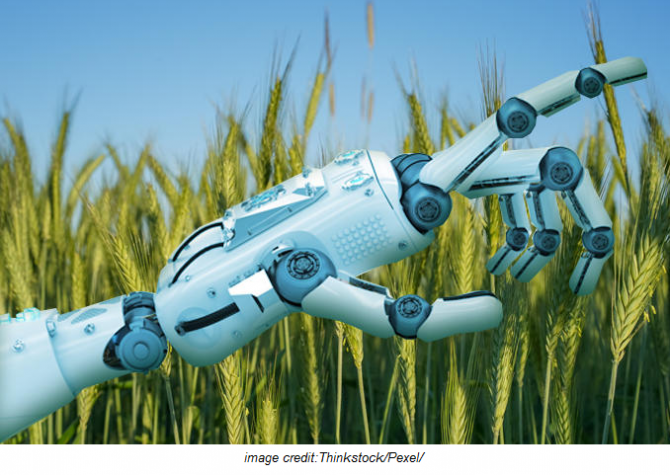25 Jul 2019

Artificial intelligence has widely emerged in different industries and is now on its way to take over agriculture. AI is now being used in agricultural farming to increase food production, improve food quality, and save costs for farmers. Experts believe that we are “on the cusp of a so-called technological revolution” [1] or more specifically, agricultural revolution. Let’s look at some of the significant applications of AI in agriculture.
One of the most common applications of AI is robotics. Robots are now being trained to do activities of a farmer like harvesting crops, weeding, etc [2]. They are often called “agri bots” or “ag robots” [3]. Yes, machines and tractors have been with us since 19th century and been a huge help ever since. However, these robots are now taking the lead and here’s why.
Aerial Imagery
In the past few years, drones are being deployed to take accurate real-time aerial shots and videos of the field and record it. This allows the farmers to check their crops without actually visiting the site. But what’s new is that they are now trained to also check on the health of the crops with the infrared sensors installed in them. This capability helps farmers prevent their crops from dying. With the real-time health check of the crops, they can easily perform necessary measures to improve or maintain the quality of their harvest, hence, maintaining yield while optimizing resources.
Weed Control
Another capability of robots nowadays is “precise weed control”. Some robots are now developed to accurately detect weeds from real crops, then get rid of them by spraying herbicides. Since herbicides are only sprayed on detected weeds, it saves a lot of resources. Also, maintaining the crops to being as organic as possible.
Harvesting
Crop harvesting is one of the most tedious things that farmers do. Why? Farmers have to check if crops are ready for harvesting. During harvest, they still have to choose which ones are fit for picking and which ones still need a little more time before being picked. Then after collecting, they have to sort which ones are of the best quality and can be sold with the best price, and which are not. Nevertheless, robots can now do these things for you. Specialized robots are now taught to pick specific fruits or vegetables with high efficiency and productivity. Some are even designed to learn the ripeness of the fruit.
Space Planning
Planting and seeding are two of the basic things done in farming. As basic as they may seem, in reality, they require a lot of time and effort to optimally plant seedlings. With crops where the distance from each other matter a lot for their health, it seems so hard to perform these manually. It especially requires much precision as it will affect the health of the plant as it grows. One recent application is a robot that performs lettuce thinning wherein seedlings are “adequately spaced apart” when planted to optimally grow the crop [4].
Conclusion
Having shown significant results from the current applications of robotics in farming, we are anticipating more and more new advances in agriculture as a result of multiple research and trials – especially highlighting drones, as promising results are seen on its initial applications. With the end goal of having a fully autonomous robot to work on fields, we can expect increasing interest in artificial intelligence to further explore potentials of it in farming.
There are a lot of applications of artificial intelligence in different industries and agriculture is the current one that advances the most and the fastest. This allows better farming and better opportunities to farmers through reducing cost, saving time and improving crop yield and quality.
Other future applications of artificial intelligence not covered here which you might also want to read on to includes yield boosting algorithms – an effort to increase yield through the use of AI, chatbots for farmers – a “ smart home helper for farmers” [5], weather prediction and many more.